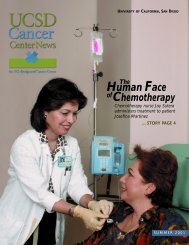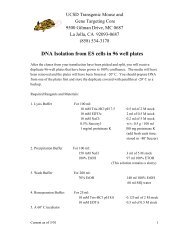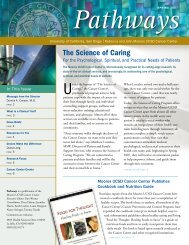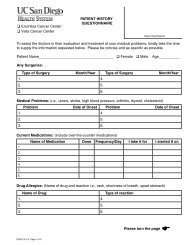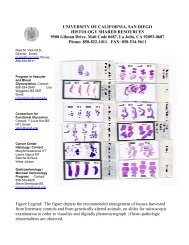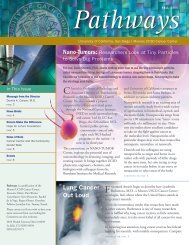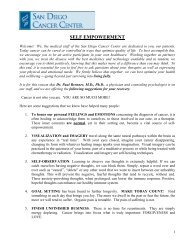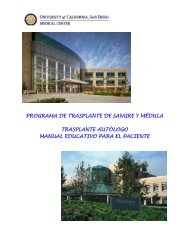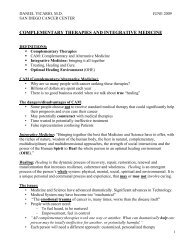Autologous Transplant Patient Education Manual - Moores Cancer ...
Autologous Transplant Patient Education Manual - Moores Cancer ...
Autologous Transplant Patient Education Manual - Moores Cancer ...
You also want an ePaper? Increase the reach of your titles
YUMPU automatically turns print PDFs into web optimized ePapers that Google loves.
Blood tests which assess how your organs are functioning and for certain infectious<br />
diseases<br />
Urine tests that measure kidney function<br />
Test for the heart may include:<br />
1) Electrocardiogram (EKG) which measures the heart’s rhythm and function.<br />
2) Echocardiogram is an ultrasound of the heart. It measures the heart’s<br />
muscle strength and is used to look at parts such as valves and chambers.<br />
3) Multiple-gated acquisition scan (MUGA) which also evaluates heart muscle<br />
function.<br />
Tests for the lungs (pulmonary) include:<br />
1) Chest x-ray<br />
2) Pulmonary function test (PFT) which involves inhaling and exhaling into a<br />
machine to measure lung function.<br />
A skeletal survey is a series of x-rays of the long bones in the body (arms, legs, spine<br />
and skull) to see if lesions are present. This test in only done on patients with multiple<br />
myeloma.<br />
A bone marrow biopsy is an outpatient procedure to obtain samples for testing the bone<br />
marrow function. After medication is given to numb the site, a needle is inserted into<br />
the back of the hipbone and a small amount of bone marrow is removed.<br />
A Computerized Tomography (CT Scan) is a special x-ray technique that produces<br />
images of cross-sections (slices) through your body. This enables your doctor to view<br />
the inside of your body at different angles.<br />
Magnetic Resonance Imaging (MRI) uses a magnetic field and radio-waves to take<br />
multiple cross-section images of your body. These slices are then put together into a<br />
three dimensional image. This shows the contrast between different types of body tissue<br />
in great detail.<br />
Positron Emission Tomography (PET scan) is a procedure in which a small amount of<br />
radio-active sugar is injected into your veins. A scanner then is used to make detailed<br />
pictures of the areas inside the body where the sugar is used. Because cancer cells often<br />
use more sugar than normal cells, these pictures can be used to find active cancer cells in<br />
the body.<br />
Decayed teeth and gum disease can cause serious infections in transplant patients. If<br />
possible, it is important to have a complete dental exam before your transplant. All<br />
dental work should be completed at least 14 days before the beginning of your<br />
preparative regimen.<br />
You will also meet with your clinical social worker to discuss non-medical aspects of the<br />
transplant<br />
Attend the autologous patient education class that is offered once a month<br />
Alternative and Complementary Therapies<br />
With growing public interest in alternative and complementary therapies comes an<br />
increased need for accurate information to be made available for patients and families to<br />
Page 16 of 51



